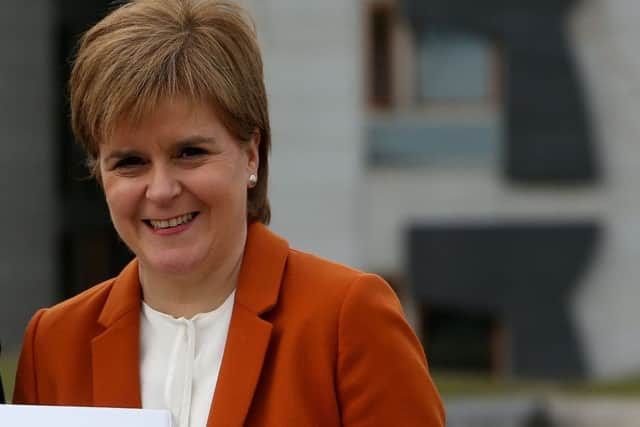Analysis: What may have caused Nicola Sturgeon to '˜restart' independence debate
How times change.
Yesterday, it was announced with minimal fuss that Kirkcaldy MP Lesley Laird, by virtue of being the only candidate, would be the new Deputy Leader of Scottish Labour.
It was a marked difference from the rancourous contest of last summer’s fight to take over from Kezia Dugdale as leader, with everything from Anas Sarwar’s business affairs to Richard Leonard’s Englishness coming up in the campaign.
Advertisement
Hide AdAdvertisement
Hide Ad

Meanwhile, the battle to replace Angus Robertson as Deputy Leader of the SNP entered its final fortnight with no sign of a suspension of hostilities between the two main candidates.
Economy Secretary Keith Brown started out the clear front-runner, but Councillor Chris McEleney has put having an independence referendum as soon as possible front and centre of his campaign, and could yet pull off a shock victory.
With the SNP’s Growth Commission report sparking debate among the pro-independence movement over the weekend, it seems proxy wars along the old fundamentalist v gradualist lines are breaking out regularly.
Nicola Sturgeon has expressed a desire to ‘restart’ the discussion on independence, something which opponents say is just retreading old ground and neglecting good governance.
But was the First Minister bounced into this course of action? Has she been outflanked by a resurgent, and external, for independence?
The Deputy Leadership
Nowhere is the internal struggle in the Yes movement more pronounced than in the SNP’s Deputy Leadership campaign.
Ms Sturgeon has so far remained aloof from the contest, but it is a safe assumption that she would prefer to have a key Cabinet ally in the role rather than an upstart local government representative.
Mr McEleney seized the initiative in the race by promising to push for a second referendum on independence within 18 months of his election.
Advertisement
Hide AdAdvertisement
Hide AdMr Brown, who initially favoured a more cautious approach, has since one-upped his rival and said a second vote could be held as early as April of next year.
Julie Hepburn, a party activist, has also pledged to kick start a nascent independence campaign, as the SNP’s estimated 100,000 members vote for who will replace former Moray MP Angus Robertson.
The Growth Commission
The time between the formation of the SNP’s Growth Commission and the publication of their report had become something of a running joke among the party’s opponents.
Indeed, the First Minister was first challenged by then-Labour leader Kezia Dugdale to publish the report in March 2017.
In the same month, Ruth Davidson took issue with previous comments the commission’s chair had made on oil revenue.
Ms Sturgeon first tasked former RBS Executive Andrew Wilson with leading the commission in September 2016.
His weighty document has won praise from some quarters for its detail, but is still seen by most of the SNP’s rivals as a flimsy case for the foundation of a new state.
Mr Wilson’s report had seemingly been due for publication for months, and Ms Sturgeon has faced accusations of pandering to her base by re-running an independence referendum she called ‘once in a generation’ in 2014.
Advertisement
Hide AdAdvertisement
Hide AdWhile Ms Sturgeon has been keen to stress that the Growth Commission’s report is the start, rather than end, of a conversation, it will clearly form a bulk of the blueprint for any second referendum campaign.
External factors have made that referendum campaign suddenly loom much larger in recent weeks.
Outside forces
Nicola Sturgeon’s response to a huge march in Glasgow backing a second referendum on independence was far from ebullient.
The First Minister tweeted a cursory thumbs-up emoji to a news report on the impressive turnout, which saw an estimated 40,000 people take to the streets.
Many think it was no coincidence Ms Sturgeon’s restarting of the independence debate came a few short weeks after the march.
It was the most prominent pro-independence march since the referendum of 2014, and crucially, it took place independently of the SNP, normally seen as the guarantors of the movement.
The march, and the subsequent reaction to it, showed that supporters of independence don’t necessarily see Scotland’s ruling party as the only vehicle for the break-up of the UK.
A point illustrated by the lukewarm, or downright hostile, response to Andrew Wilson’s report from the left of the Yes movement, who saw it as insufficiently radical a vision of a new country.
Advertisement
Hide AdAdvertisement
Hide AdIt may yet prove that the coherent message and discipline that has marked out the SNP in recent years could give them a solid base to continue to lead and not follow in terms of timing of a second referendum.
Recent events, however, have proved that there are significant forces, from within and outwith the party, that could yet wield huge influence over Nicola Sturgeon.
